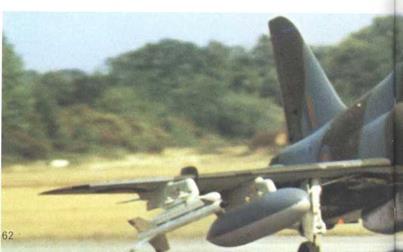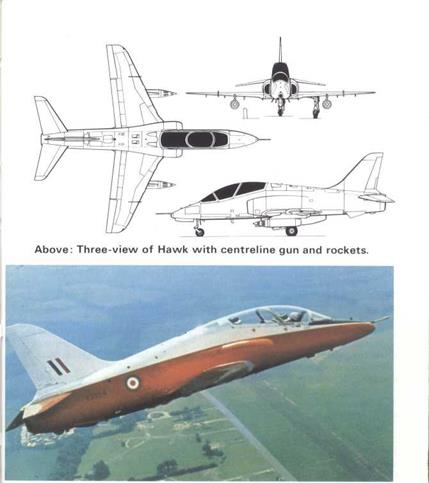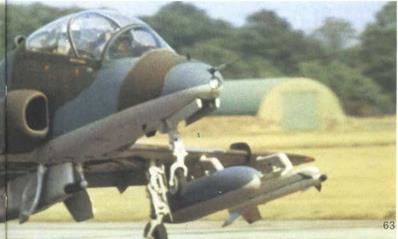HSA (BAe) Hawk
P.1182 Hawk T.1
Origin: British Aerospace, UK.
Type: Two-seat trainer and tactical multi-role.
Engine: One 5,340lb (2422kg) Rolls-Royce/Turbomeca Adour 151 two-shaft turbofan.
Dimensions: Span 30ft 10in (9-4m); length (over probe) 39ft 23,In (11 -95m); height 1 3ft 5in (4-09m).
Weights: Empty 7,450!b (3379kg): loaded (trainer, clean) 12,0001b (5443kg), (attack mission) 16,2601b (7375kg).
Performance: Maximum speed 630mph (1014km/h) at low level; Mach number in shallow dive, 1-1; initial climb 6,000ft (1830m)/min; service ceiling 50,000ft (15,240m): range on internal fuel 750 miles (1207km); endurance with external fuel 3 hr.
Armament: Three or five hard-points (two outboard being optional) each rated at 1,0001b (454kg); centreline point normally equipped with 30mm gun pod and ammunition.
History: First flight 21 August 1 974; service delivery 1976.
Users: Finland, Indonesia, Kenya, UK (RAF).
 |
Development: The only new all-British military aircraft for 15 years, the Flawk serves as a model of the speed and success that can be achieved when an experienced team is allowed to get on with the job. To some degree it owes its existence to the escalation of the Jaguar to a power and weight category well above that economic for use as a pure trainer. Britain never participated in the Franco-German Alpha Jet programme and instead played off the two British airframe builders, finally making a choice between the Adour without afterburner and the less powerful Viper 632. With the Adour, the Flawk had a chance to be a world-beater, and backed by an immediate RAF order for 175 the Hawker Siddeley plants rapidly completed design, tooled for fast manufacture with assembly at Dunsfold and completed development of the RAF T.1 version all within the first two years of the programme. By October 1976 a dozen aircraft had flown and deliveries had begun to the RAF to replace the Gnat, Hunter and, eventually, Jet Provost, in roles ranging from basic flying to advanced weapon training. Thanks to very rapid development the Hawk was kept to the original budget and price and by late 1979 nearly all the 175 aircraft for the RAF had been delivered. So pleased is the RAF that a repeat-order has been requested, though funds are awaited. A proportion of Hawks may be singleseat dedicated close-support machines.
 |
Above: One of approximately 100 Hawk T.1 multi-role advanced trainers serving with 4 Flying Training School at RAF Valley.

Below: In this configuration about 50 Hawks are flying with No 234 Sqn, part of No 1 Tactical Weapons Unit, at RAF Brawdy.










